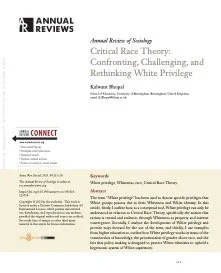By: Amber Woodburn McNair, Jason Reece, Destiny N. Thomas, Imani Mitchell-Wyatt, Julia Nagy, and Sara Kaplan
Airport Cooperative Research Program (ACRP) Project 02-99: Incorporating Environmental Justice and Equity Principles and Data into Airport Decision-Making provides resources to educate and support airport practitioners integrating environmental justice, equity principles and data into airport decision-making. Airports (and the impacted communities that surround them) need resources to carefully assess and respond to inequitable outcomes, particularly with respect to impacts felt by airport passengers, the airport workforce, and the airport-adjacent communities whose environments are impacted by airport development and operations. This document is one of two research publications associated with ACRP Project 02-99.
To adequately incorporate environmental justice, equity principles, and data into airport decision-making processes, it is critical for practitioners to understand the historical context of current conditions. This publication provides evidence that the structural origins of inequity, as experienced in the United States, can be traced back to four broad conceptual themes: group-based othering (Chapter 2), settler colonialism (Chapter 3), economic systems of racial capitalism (Chapter 4), and systemic oppression (Chapter 5). Where Chapters 2 through 5 focus on key concepts and provide specific examples pertinent to the air transportation system today, Chapter 6 begins to explore the aspirational goal of an inclusive, equitable, and just airport planning and decision-making process. Chapters 2-6 each begin with a one-page “Insight Warm-Up” that lists the learning goals for the chapter and short prompts about the relevant historical context, lenses and ways of knowing, and present-day legacies in aviation. Overall, this publication intends to improve a reader’s knowledge of systemic racism within the United States, as well as improve their understanding of the links between historical instances of harm to outcomes that persist within the aviation industry today (with a focus on airports where applicable).
The intended audience for this document includes practitioners who are tasked with setting forth equitable policies and procedures, practitioners who are responsible for prioritizing projects and fiscal allocations, planners whose work includes designing infrastructure and implementing engagement strategies, and practitioners tasked with collecting, analyzing, and reporting on equity-related data, among others. Each chapter contains specific learning objectives that guide airport practitioners to reflect on a range of systemic inequalities and consider ways to intervene on current practices within their industry, within their organization, or through their specific role.
The research team sought to highlight lived experiences and offer qualitative depictions of the ways people experience inequities in terms of airport planning, siting, and operations. This publication illustrates the meaning of terms like environmental justice and equity by exploring the ways people experience the processes by which inequities occur within transportation and airport planning. As described throughout this publication, those processes are fostered by racism, ableism, sexism, homophobia, xenophobia, and anti-indigeneity. This publication’s narrative approach to illustrating environmental justice and equity is an analytical departure from the (more common) practice of listing brief definitions or brief descriptions of inequities, which often lead to over-simplification or ‘checklist thinking’ that can undermine efforts to orchestrate more equitable processes and outcomes.
The National Academies Press 2024





















